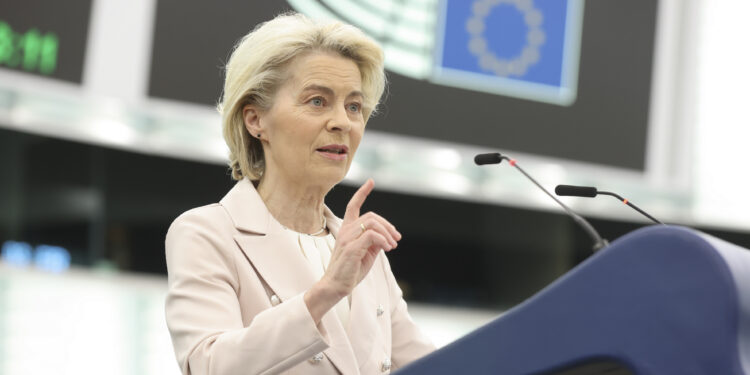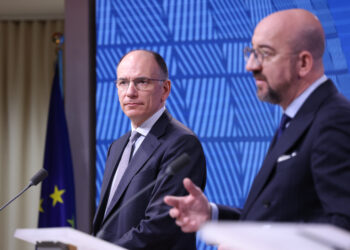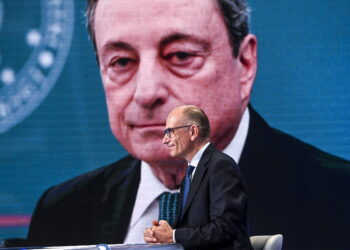Brussels – The European Commission’s work to revitalize the Capital Markets Union begins, following the guidelines presented – or still being finalized – by Enrico Letta and Mario Draghi, the two former Italian prime ministers tasked with charting the future of the Union’s competitiveness. “Public investment is not enough. We need to find a systemic solution that mobilizes Europe’s immense private capital,” EU executive President Ursula von der Leyen urged, ahead of what the Commission will have to advance after the mandate received last week from the leaders of the 27 member countries: “An essential part of this solution is the completion of the Capital Markets Union.”

Speaking today (April 23) at the last plenary session of the European Parliament for this legislature — before the June elections — the Commission chief presented the outcome of discussions at the April 17-18 Extraordinary European Council, particularly on the issue of competitiveness: “We have heard some very good ideas from Letta on our Single Market,” outlined in his high-level report. The most pressing issue is the “key factors that determine costs, prices, and productivity in Europe,” and it was from the EU leaders’ summit that the Commission received a “clear” mandate to move forward on three “vital issues,” President Von der Leyen made clear to MEPs. First and foremost is the harmonization of national rules “on issues such as insolvency” to provide investors with “the predictability they need,” the design of “cross-border savings products for retail investors,” and the strengthening of EU-wide supervision” of the most important market participants.”
All of this will converge in work in Brussels that will have a clear goal, according to von der Leyen: “ If we are to fund the new industrial revolution of our times, we must mobilize Europe’s private capital.” The urgency stems not only from years of “deadlock in the Council on many crucial aspects of the Capital Markets Union” but, above all, from estimates of the value added to the European economy: “EUR 470 billion – this is the additional private investment we could raise every year if we completed the Capital Markets Union.” The revival of this theme came with the conclusions of the last European Council, in which the member states and the Commission were asked to commit to “all identified measures that are necessary to create truly integrated European capital
markets which are accessible to all citizens and businesses across the Union,” including by improving “convergence and efficiency of the supervision” over the “most systemically relevant” cross-border actors.

The head of the report on the future of the Single Market, Enrico Letta (April 18, 2024)
“The Capital Markets Union is our European Inflation Reduction Act,” European Council President Charles Michel claimed at the end of last week’s extraordinary summit, recalling that “the EU has 33 trillion euros of private savings. We need to find ways to channel them into our businesses.” Alongside him at the press conference, the Commission President von der Leyen anticipated the need for “a major push to move forward and focus on a common European framework that adds value, reduces costs, and facilitates access to capital.”
What is the Capital Markets Union
The Capital Markets Union is a plan to make investments and savings flow throughout the Union “so that it can benefit consumers, investors, and companies, regardless of where they are located,” according to the EU Commission. While the road began with the 1957 Treaty of Rome and continued with the free movement of capital enshrined in the 1992 Maastricht Treaty, the creation of a true Capital Markets Union has yet to be realized. In 2015, the Jean-Claude Juncker-led Commission adopted the first action plan with over 30 initiatives that were supposed to create the building blocks of an integrated capital market in the EU by 2019. Due to the failure of this initiative, in September 2020, the von der Leyen Commission set out a new action plan with 16 legislative and non-legislative measures with three main objectives: “Supporting a green, inclusive and resilient economic recovery, making the EU an even safer place to save and invest for the long term, and integrating national capital markets into a true single market.”

From left: former Italian prime ministers Enrico Letta and Mario Draghi, respectively responsible for the high-level report on the future of the Single Market and responsible for the report on the future of European competitiveness
With the reports from Italy’s two former prime ministers, Letta and Draghi – on the future of the Single Market and the future of European competitiveness, respectively – the Commission services will benefit from additional support, which is also accelerating the march toward a Capital Markets Union in the Council. “A concerning trend is the annual diversion of around €300 billion of European families’ savings from EU markets abroad, primarily to the American economy, due to the fragmentation of our financial markets,” the Letta report underlines, highlighting “a significant inefficiency in the use of the EU’s economic assets.” The report calls for a “significant transformation” through the “creation of a Savings and Investment Union, developed from the incomplete Capital Markets Union,” not only to “keep private European savings within the EU” but also to “attract additional resources from abroad.”
In this context, former premier Letta warns that “without the private resources that will emerge from the establishment of a strong and authentic Savings and Investments Union, it will be extremely challenging to resolve the internal divisions within Member States concerning the allocation of national and European public resources needed to cover the costs of the transition.” In this regard, it is also necessary to recall what former premier Draghi said at the High-Level Conference on the European Pillar of Social Rights about his report on the future of European competitiveness. “The public sector has a big role to play. We can take advantage of the great capacity to borrow in the market, but the bulk of investments must be covered by the private sector.” An explicit reference –speaking of the most appropriate instruments for investment — to “advance” the work of the Capital Markets Union, not coincidentally defined as “an indispensable part” of the overall strategy for European competitiveness: “The EU can count on a lot of private savings, but they often end up in bank deposits and do not help financial growth,” Draghi warned.
English version by the Translation Service of Withub










